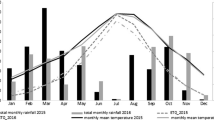Abstract
Evaluation of winter wheat cultivars has been carried out in relation to their crop capacity, ecological stability, and plasticity under conditions of the light grey forest soils of the Nizhny Novgorod oblast. In 2012–2016, the crop capacity of the cultivars included into the study was 53.0 centner/hectare on average (V = 23.3%) varying from 16.3 to 89.2 centner/ha; the year-to-year and cultivar-to-cultivar difference reached 51.7 and 12.4 centner/ha, respectively. The crop productivity was influenced mainly by weather conditions (73%), whereas the cultivar contribution made only 9%. The maximum stability and plasticity were observed for the soft winter wheat cv. Nemchinovskaya 57 bred by the Nemchinovka Federal Research Center. The cultivar demonstrated a low variation coefficient (33%) and the highest homeostaticity (1.59) and stress resistance (47.4). This cultivar was also determined as the most adaptive one under conditions of the Nizhny Novgorod region.

Similar content being viewed by others
REFERENCES
Zhuchenko, A.A., Resursnyi potentsial proizvodstva zerna v Rossii (teoriya i praktika) (Resource Potential of Grain Production in Russia (Theory and Practice)), Moscow: Agrorus, 1109.
Zhuchenko, A.A., Adaptivnaya sistema selektsii rastenii (ekologo-geneticheskie osnovy) (Adaptive System of Plant Breeding (Ecological and Genetic Basics)), Moscow: RUDN, 2001, vol. 1, pp. 616–628.
Sapega, V.A. and Tursumbekova, G.Sh., Estimation of spring wheat varieties in terms of yield and adaptability parameters, Russ. Agric. Sci., 2013, vol. 39, 403–408.
The State Program for the Development and Regulation of Markets for Agricultural Products, Raw Materials, and Food for 2013–2020. The Decree of the Government of the Russian Federation No. 717 of July 14, 2012.
The Federal Law “On Grain and Products of Its Processing” of December 5, 1998.
Goncharenko, A.A., Ecological sustainability of cereal varieties and selection tasks, Zernovoe Khoz. Ross., 2016, vol. 44, no. 2, pp. 31–36.
Sapega, V.A., Productivity, the realization of its potential, and the adaptability of spring wheat varieties, Dostizh. Nauki Tekh. APK, 2017, vol. 31, no. 10, pp. 49–52.
Goncharenko, A.A., Makarov, A.V., Ermakov, S.A., Semenova, T.V., and Tochilin, V.N., Evaluation of ecological stability and plasticity of inbred lines of winter rye, Russ. Agric. Sci., 2015, vol. 41, pp. 87–94.
Ionova, E.V., Gaze, V.L., and Nekrasov, E.I., Prospects for the use of adaptive zoning and adaptive crop breeding (review), Zernovoe Khoz. Ross., 2013, vol. 22, no. 3, pp. 19–21.
Volkova, L.V., Bebyakin, V.M., and Lyskova, I.V., Plasticity and stability of spring wheat varieties and breeding forms according to grain productivity and quality, Russ. Agric. Sci., 2010, vol. 36, pp. 1–4.
Metodika gosudarstvennogo sortoispytaniya sel’skokhozyaistvennykh kul’tur (Methods of State Variety Testing of Agricultural Crops), Moscow: Kolos, 1985.
Metodicheskie rekomendatsii po ekologicheskomu sortoispytaniyu sel’skokhozyaistvennykh kul’tur na primere zernovykh (Methodological Recommendations on Ecological Variety Testing of Crops on the Example of Cereals), Batalova, G.A., Sheshegova, T.K., and Starikov, V.A., Eds., Kirov: NIISKh Severo-Vostoka, 2013.
Obzor agroklimaticheskikh uslovii za 2012–2016 gg. (Agrometeostantsiya “Roika”) (Overview of Agro-Climatic Conditions for 2012–2016 (Agrometeorological Station Roika)), Nizhny Novgorod, 2013–2017.
Pakudin, V.Z., Parametry otsenki ekologicheskoi plastichnosti sortov i gibridov. Teoriya otbora v populyatsiyakh rastenii (Parameters for Assessing the Environmental Plasticity of Cultivars and Hybrids. Theory of Selection in Plant Populations), Novosibirsk: Nauka, 1976.
Goncharenko, A.A., On the adaptability and environmental sustainability of cultivars of grain crops, Vestn. Ross. Akad. S-kh. Nauk, 2005, no. 6, pp. 49–53.
Khangil’din, V.V. and Biryukov, S.V., The problem of homeostasis in genetic selection studies, Genet.-Tsitol. Aspekty Sel. S-kh. Rast., 1984, no. 1, pp. 67–76.
Author information
Authors and Affiliations
Corresponding author
Ethics declarations
Conflict of interest. The authors declare that they have no conflict of interest.
Statement on the welfare of animals. This article does not contain any studies with animals performed by any of the authors.
Additional information
Translated by N. Statsyuk
About this article
Cite this article
Petrov, L.K. Evaluation of the Crop Capacity, Ecological Stability, and Plasticity of Winter Wheat Cultivars Under Conditions of the Nizhny Novgorod Oblast. Russ. Agricult. Sci. 46, 323–327 (2020). https://doi.org/10.3103/S106836742004014X
Received:
Revised:
Accepted:
Published:
Issue Date:
DOI: https://doi.org/10.3103/S106836742004014X




